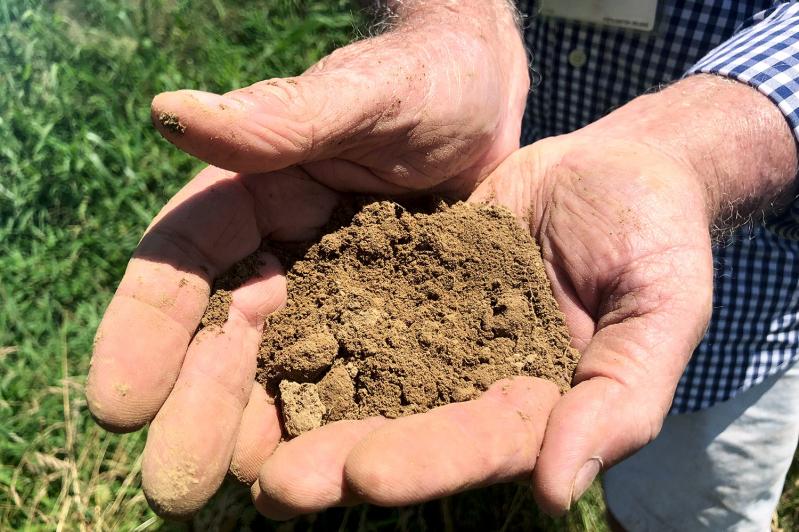The mound of earth behind the Bridgehampton School is one of the biggest John Daniels has seen in his lifetime on the East End.
Some 10 feet tall and four or five times as long, it’s not just any old pile of dirt. It is Bridgehampton loam, and it might as well be a pile of gold.
“It’s the best soil in the whole country,” Mr. Daniels, the school’s maintenance mechanic, said this week. “You can’t find soil like this anywhere else.”
Crews excavated more than 100 cubic yards of it — as much as 125 cubic yards, school officials estimate — over the last several months when they dug for a geothermal system and foundation behind the school as part of the district’s $29.4 million expansion and renovation project.
But contractors began carting it away, in what would be a normal procedure for a major project like this one, until Mr. Daniels spoke up. Two weeks ago, at a meeting between school officials and those overseeing construction there, contractors agreed to keep the Bridgehampton loam on site to be repurposed on the grounds when the expansion and renovation project is nearing completion.
Robert Hauser, the school superintendent, said the loam will be put to good use on the campus. Some will be restored to the ground as grading against the new part of the building, he said. Some of it will support new landscaping, some will go to cover up the geothermal heating and cooling system dug into the ground behind the school, and some will help root a new natural-grass baseball and softball field.
The Bridgehampton loam is “important from a preservation point of view,” Mr. Hauser said.
Judiann Carmack-Fayyaz, who teaches classes in technology, botany, and agriculture at the school, says she hopes the school will also use the soil to build a grass amphitheater similar to the one at the LongHouse Reserve in East Hampton. She envisions the amphitheater as an outdoor classroom, a venue for poetry readings and the performing arts, and more. Or, she said, “we could build a raised walkway around the perimeter” of the campus, will little hills and valleys that could be used for gym classes and wellness programs.
But whatever its destiny, she said, the fact that the Bridgehampton School has retained this soil is paramount.
“It’s really the sea, the water, the soil that make this place special,” Ms. Carmack-Fayyaz said.
In his 1979 book “The South Fork: The Land and the People of Eastern Long Island,” Everett T. Rattray, a former editor of this newspaper, wrote about the region’s “fine sifted-down soil from the glacier, rich with the humus of 120 centuries.” The land is “the best and oldest evidence of our past,” Mr. Rattray said in his book.
“From Scuttlehole, Bridgehampton’s ridgepole, the view is always toward the Atlantic, south over thousands of acres of farmland, the famous Bridgehampton loam,” he wrote. “Farmed intensively for three centuries now, it would support some of its families for another three if it could be saved from subdivision and paving for tennis courts and driveways. The soil slopes gently, dropping perhaps 150 feet in two and a half miles between moraine and ocean beach. The landscape’s chief characteristic is its flatness, the smoothness one would expect in an old, old landscape. Yet this is a new landscape, formed yesterday in terms of geologic time.”
Jim Ash, a naturalist and geologist who was a founder of the South Fork Museum of Natural History and its executive director for 14 years, concurred with both Mr. Rattray’s and Mr. Daniels’s conclusions on the Bridgehampton loam.
“Here you have 8 to 12 inches of beautiful, loamy soil, with not a lot of rocks in it. It’s some of the finest soil for growing in the country,” said Mr. Ash, who happens to be Mr. Daniels’s brother-in-law. “It came from 20,000 years ago when the glacier was here in the Ice Age. It advanced as far south as Long Island and couldn’t go any farther south because the rate it was melting was equal to how fast it was advancing. It acted like a giant conveyor belt for thousands of years, bringing all the material that was in it, on it, under it, suspended in it.”
Mr. Ash recalled a time when one could drive south of the highway from Sagaponack to Southampton and see just a few farmhouses. “It was all agricultural land,” he said.
Then came the houses, then the bigger houses, he said. Builders “scrape off all the loam. They steal it, really. They dig the holes and sell it.”
He said the municipalities could, if they wanted to, impose restrictions on builders so that all soils must be kept on the properties they came from.
“I see very few examples of that happening,” Mr. Ash said, “although with more environmental awareness today, that might happen more now.”
Mr. Daniels, who was the head custodian when he tried to retire about eight years ago from the Bridgehampton School but came back in 2012 in the maintenance department, said the contractors went 35 to 40 feet down and made separate piles for the loam, clay, and sand they dug up. He explained that a bluegrass cover was planted on the pile to keep the soil from blowing away or eroding in the rains.
The Bridgehampton loam is golden-brown in color. It feels loose, cool, and gritty to the touch, and leaves a fine dust on your hands — or feet, if you accidentally step in it. Ms. Carmack-Fayyaz explained that it can retain water for long periods of time, making it perfect for nourishing crops like corn and wheat.
“I would like to see people learn a lot more about the resources here,” she said. “The soil is everywhere. We need to really revere it and understand its importance.”

